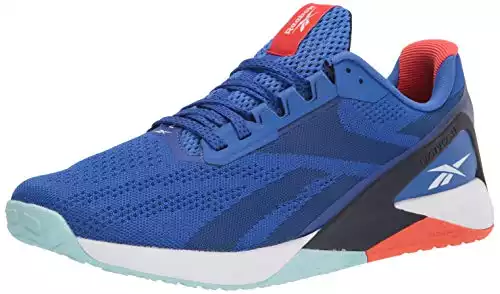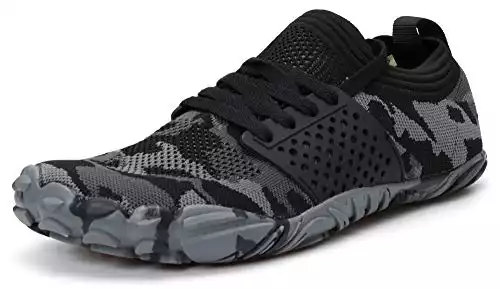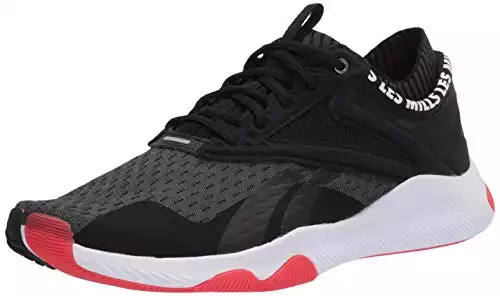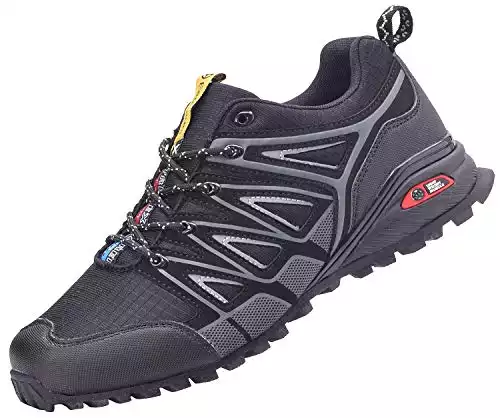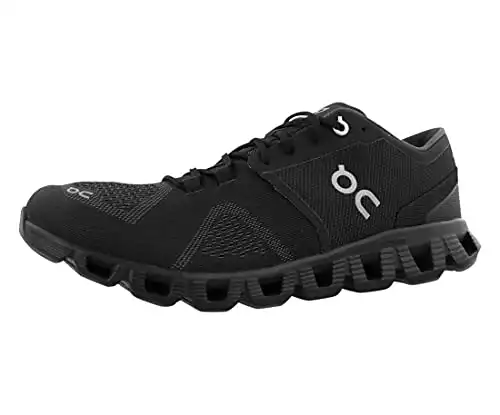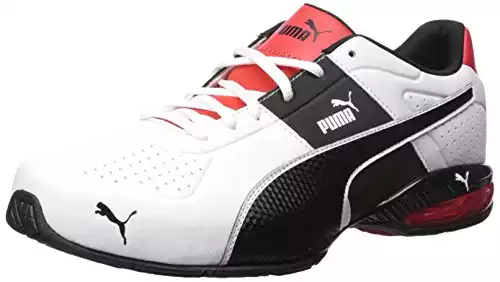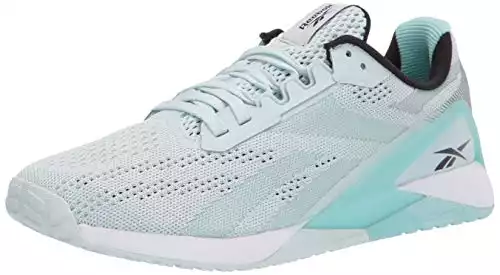Equipment
The 10 Best Cross Training Shoes
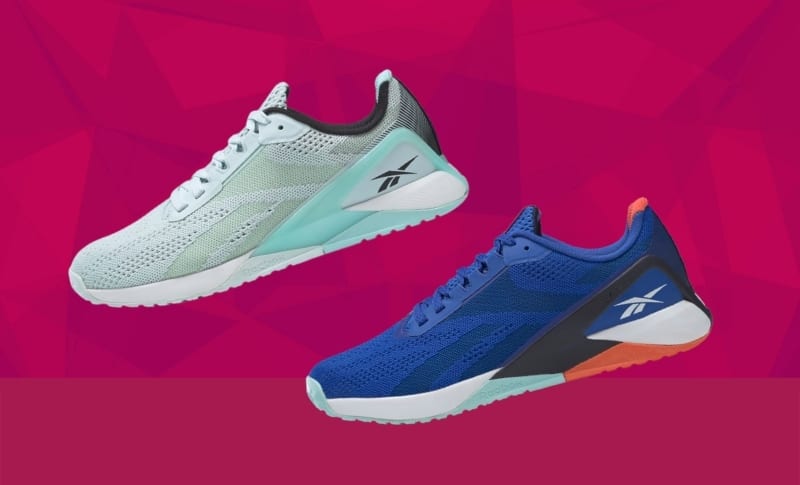
What are the best cross training shoes on the market?
Not so long ago, running shoes dominated all corners of athletic training footwear.
Sprints, endurance runs, weight-training, climbing – what difference does your shoe make? So long as they’re comfy, no big deal. Right?
Not quite. Training knowledge has stepped its game up. Funding is pouring into research surrounding optimal athletic performance.
Turns out our feet play a big role in everything from muscle activation and spinal stability to joint health and shoulder alignment.
Our shoes play a significant ancillary role to our feet; providing ankle, sole, and arch support, supplying reactive feedback, and reducing impact stress.
The popularity of cross training, functional fitness, and multi-discipline athletics introduced a complex problem for sports footwear.
People now simultaneously require support while running, stability while lifting, and flexibility while climbing or jumping.
Running shoes are great until they start wobbling under a heavy squat. Flat sole shoes are perfect for lifting, but miserable to run in.
The answer? Cross training shoes. Blending elements found in running, trail, climbing, lifting, and lifestyle shoes, cross trainers are designed to be the jack of all athletic trades.
Still, every shoe is different. There are wide and narrow toe boxes, thin contours or thick supports, cushioned heels, and flat soles. Selecting the right shoe for you can take some investigation.
Take a breather. We’ve already gathered 10 of the best cross training shoes on the market – based on reviews, quality, and design features. Read on.
The Best Cross Training Shoes Compared
Our equipment lists are created by researching the best-reviewed products from the most reputable companies and web sources.
Here’s our list of the 10 best cross training shoes:
In A Rush? Here’s Our Top Pick:
Reebok has done a lot to become a definitive name in cross training athletics.
Once the primary sponsor behind the CrossFit games, Reebok has spent the past decade driving innovations in versatile training gear.
The Reebok Nano XI shoes hold to the standard set by the company’s growing cross training legacy.
Utilizing a proprietary Flexweave material stitching, the shoes flow with the natural contours and movements of the feet.
The Floatride foam lining at the heel provides athletes with a supportive, force-reactive surface to absorb repetitive impacts and prime explosiveness.
The mid-sole EVA foam offers further shock dampening while memorizing the foot’s shape and adjusting for dynamic, multidirectional movement.
Each pair includes a heel clip to ensure users are locked in regardless of the activity, and at any level of intensity.
It helps that the Nano XIs look great, too.
10. WHITIN – Minimalist Barefoot Shoes
Finding a solid pair of training shoes generally hits a wall early on at the price.
Many of the upper market options can run a hundred dollars or more. You’re paying for the foam tech, advanced contouring, proprietary stitching, and branding.
For a minimalist, all the cutting-edge features might seem unnecessary. You just want something that offers some support, versatility, and lets your feet do the bulk of the work.
The WHITIN Minimalist Barefoot shoes are the perfect option for someone just getting started with cross training or barefoot footwear.
Each pair is designed to closely match the anatomy of the foot, adapting to the natural movement from toes to heel.
The toe box is stitched wide to accommodate unhindered travel of the toes during activity.
A thin, zero-drop sole allows the feet to connect and react to the ground directly without rolling.
The shoe engineering encourages native proprioception of the feet, nurturing posture and joint health.
Every pair of WHITIN Minimalist Barefoot shoes are made with entirely vegan materials.
Pros
- 100% vegan manufactured materials
- Minimalist design accentuates and strengthens the natural ability of the feet
- Extremely high value, affordable price point
Cons
- Minimalist shoe designs may not provide the desired support or ankle/toe protection
- Reviews note the toe box may be a bit too large – allowing for too much toe movement relative to the rest of the foot
9. Reebok – HIIT TR
Reebok has an entire suite of training shoes at the ready to meet the needs of different athletes.
The HIIT TR shoes target application lies in its namesake: high-intensity interval training. HIIT may involve sprints, runs, aerobics, lifting, or any combination of training activities.
An appropriate shoe will have the support to absorb repetitive shocks, and the staying power to effectively translate strength from the floor into the body.
The HIIT TRs stand ready with a flexible, lightweight, and breathable design. The rubber sole grips the floor securely and maintains traction – even in humid, sweaty conditions.
The EVA foam mid-sole contours the foot and offers gentle, second-skin feeling support along the line of force from heel to toe.
Pros
- Great price point and value for a Reebok shoe
- EVA foam for high grade of force absorption and joint protection
- A very grippy sole guarantees floor traction on many different surfaces
Cons
- Toe box may be too narrow for wider feet
- Some reviews criticize the ankle support as being too flimsy to be fully effective
8. Vibram – KSO EVO
Vibram broke onto the scene a bit over a decade ago for their take on an anatomically analogous shoe.
A little unorthodox in appearance, Vibrams are stitched to include individual toe compartments rather than a toebox.
Vibram’s philosophy is that human feet are meant to engage with the ground front-first, toes spread and braced to transfer force along to the heel and ankle.
The KSO EVO shoe design supports natural movement of the foot through a snug, glove-like fit.
Breathable, flexible, and durable, the EVOs are equipped with Vibram’s XS TREK zero-drop sole technology to bolster traction and proprioceptive feedback with the ground.
Pros
- Original Vibram “Five Finger” minimalist design – fits the foot like a glove, adjusting to all natural movement
- XS TREK zero-drop sole technology for a fully balanced foot-to-floor impact
Cons
- Minimalist shoe designs are not support-heavy – there can be a learning curve to their use, and they may be uncomfortable at first
- Reviews have mentioned some tearing issues near the toe frames after a few months of regular use
7. Eagsouni – Cross Training Shoes
Maybe you’re not a minimalist, but would still like a more affordable option than the upper echelons. Eagsouni has you covered.
The Eagsouni Cross Training shoes are tailored with the same principles as top tier trainers, but at half the cost (or less).
These pairs are built with a lightweight, flexible, and breathable mesh knit. They’ll carry on your feet weightlessly and dispose of moisture as it comes along.
The sole is patterned to achieve an anti-slip effect, resisting abrasion while guaranteeing stable traction with the ground.
The material stitching is intended to endure all climates, environments, and applications.
Camping, trail running, gym mats, casual wear – the Eagsouni’s offer total versatility at an extremely value-intensive price point.
Pros
- Very high value and exceptionally economical price point
- Large and accommodating toe box – great for wider feet
Cons
- Sole design includes a slightly raised surface near the heel – can be very uncomfortable for individuals looking for a level sole surface
6. Under Armour – Charged Commit 2.0
Under Armor is an industry giant and arguably one of the first cross training focused brands.
To that end, even UA’s specialized equipment tends to adopt a number of all-purpose features.
The Charged Commit 2.0 running shoes are a perfect showcase of cross training principles blended into specialty design.
Under Amor’s Charged Commits are built with a dual external heel for a close grip about the foot.
The heel works in conjunction with the leather mid foot saddle to stabilize the entire length of the foot.
The Charged Cushioning encases the foot with a shock-absorbing, movement-supporting foam material.
The foot’s proprioception is given a helping boost via the reactive feedback of the specially designed insole and outsole.
Pros
- Proprietary Under Armor Charged Cushioning for specialized shock absorption and foot contouring
- Reaction-boosting insole and outsole design elements – great for explosive sprints and running
Cons
- Running-centric design – may not be as adaptable to weightlifting movements as competing options
5. ON – Cloud X – Women
The ON Cloud X trainers are one of the more unique looking models on our list – to their benefit.
ON’s CloudTec technology ensures complete force absorption on every foot strike, while sustaining static stability when not in motion.
The shoes are virtually weightless and are lined with zero-gravity foam. A specially tailored mesh ensures full breathability.
The synthetic outsole is sturdy and patterned expressly for floor traction.
Pros
- Nearly weightless stitching and overall design – zero gravity foam
- Snug fit for smaller feet
Cons
- Several reviews issued against the stitching of the sole after moderate use – may separate from the mesh lining
4. PUMA – Cell Surin 2
PUMA, like Under Armor and Reebok, is an undisputed household name for athletic wear.
They’ve spent decades developing top grade footwear and athletic equipment – and it’s no surprise they’ve modeled their own cross trainers.
The Cell Surin 2s descend from PUMA’s 10cell line, focused on lifestyle and performance specs. The aesthetic of the shoes reflects their design intent – modern, sleek, and dressable.
The Cell Surin 2s are built out of a synthetic-leather composite, making them highly durable and moisture-resistant.
The outsole grips firmly, and the rigid spring heel support offers a powerful balance of force absorption and stability.
Uniquely, the sole of these shoes sit a bit lower under the ankle ridge – providing slightly more ankle support than lower-rise shoe options.
Additionally, the toe box is slightly more narrow than most other cross trainers.
Pros
- Synthetic-leather composite material ensures high grade of durability and moisture resistance
- More narrow toe box perfect for smaller or less wide feet
- Deeper sole bed – provides more support around the ankle
Cons
- Limited arch support and heel might put some wearers off
3. Under Armour – HOVR Rise 2
Under Armor makes another appearance – this time in the top 3. The HOVR Rise 2 cross trainer shoes drop the specialty appeal and dedicate every feature to versatility and adaptability.
HOVR technology foam is implemented for patent-grade force absorption and impact distribution.
The compression mesh engineering reacts to the movement of the feet during impact and keeps them rooted.
Resillient to scuffs and scathing, these shoes are exceptionally lightweight and well-ventilated.
The overlapping saddles and heel ridge grasp the foot securely and facilitate total cohesion along the sole.
Pros
- HOVR foam technology for top tier shock absorption
- Compression mesh engineering keeps the foot in place during impacts
Cons
- The entire shoe is built very snug – individuals with broader ankles, heels, or toes may struggle to get them on comfortably unless sized up
2. Reebok – Nano X1 – Women’s
These versatile shoes meet the needs of athletes on all ends of the spectrum. We can’t overstate it. As such, we’ve tossed the Reebok Nano X1s both of our top spots – one for men, one for women.
The Nano X1s are fitted with specialized Flexweave knitting to shore up on breathability, cutting odors and moisture stagnancy.
The weaved stitching also supports multidrectional movement and natural adjustments to foot positioning during intense exercise.
The built-in Floatride and EVA foam technology holds the feet in place for consistent floor contact and force absorption.
The heel clip feature keeps you locked in and safe from any lost or loose shoe mishaps during a HIIT session.
Pros
- Floatride cushioning navigates the distribution of force and absorbs shock at the heel flawlessly
- EVA foam at the midsole aligns and stabilizes the foot securely during movement
- Heel clip keeps the foot locked in during high intensity exercise
- High ankle wall for improved support
Cons
- Minimal heel cushioning – learning curve may be involved in training the foot to be comfortable
1. Reebok – Nano X1 – Men’s
The Nano XIs provide a premier cross training experience. The list of technical features shines out ahead of the competition.
Floatride and EVA foam sole lining for maximized shock absorption and contouring. Flexweave stitching for peak maneuverability and breathability.
Each material component contributes to force dampening, reactive feedback, and full-scale integrated support along the entire foot.
Pros
- Floatride cushioning navigates the distribution of force and absorbs shock at the heel flawlessly
- EVA foam at the midsole aligns and stabilizes the foot securely during movement
- Heel clip keeps the foot locked in during high intensity exercise
- High ankle wall for improved support
Cons
- Minimal heel cushioning – learning curve may be involved in training the foot to be comfortable
FAQs About Cross Training Shoes
Here are our answers to some of the most frequently asked questions about cross training shoes:
Q: What are cross training shoes?
Cross training shoes are multi-purpose footwear for athletes all along the training spectrum. Typically, they are built to accommodate a variety of applications.
Where most running shoes are singular minded in providing sole and ankle support via cushioning, cross trainers have to consider dynamic, static, jumping, and loaded movements.
In many cross training exercises, there is a demand for stability and rotational support not found in traditional running footwear.
Q: What are cross training shoes for?
Cross training shoes are intended for athletes and fitness enthusiasts who perform a wide variety of training styles.
They’re appropriate for use in all kinds of training: weightlifting, running, climbing, aerobics, cycling, CrossFit, OrangeTheory, and more.
Modern exercise science has pivoted the dominant view on foot health. In the past, athletes were encouraged to run heel first and roll to the front of the foot.
A growing body of research has started to unlock the secrets of natural foot movement.
The results have shown human feet are better purposed by running toe-first, and that our natural physiology prefers such movement.
Cross trainers and “barefoot” shoes pick up on that more naturalized approach.
The zero-drop curvature of most trainers supports a flexible toe-first impact, flowing from the instinctual movement of the foot as you move around in non-linear, functional ways.
Q: Can you run in cross training shoes?
Absolutely. Cross training shoes might even be considered more effective for certain types of runs, such as trail runs.
The built-in flexibility and foot contouring of cross trainers means you’ll be better suited on runs that require constant microadjustments (e.g. to move across roots, unlevel ground, rocks, etc.).
Further, if you are incorporating runs between stationary exercises, cross trainers will provide a seamless transition between movements.
Cross trainers generally emphasize a more natural running gait that is toe-first.
This can be observed in the design of the shoes, where the heel and arch support can be less pronounced in favor of a slightly raised toe box.
The more primal patterning of the feet helps strengthen tendons and protect joints from unnecessary shearing force during sprints and long runs.
Q: Do cross-training shoes make a difference?
Any shoe will impact your performance in some way. You wouldn’t want to run a marathon in flat sole Converse shoes.
You also wouldn’t want to squat 500 lbs on a pair of cushy, unstable running shoes.
A shoe can be perfect for a given application, but a complete hindrance to another.
The same reality applies to cross training enthusiasts. If you cannot effectively transition between movements, and sustain a level of optimal performance, then you’re leaving effort on the table.
Imagine a HIIT wherein you’ll be running a 40 meter sprint between box jumps and a 10-rep squat. If you wear squat shoes, you’ll be locked to the floor and unable to run or jump effectively.
If you wear running shoes, you will bounce and roll all over the place during the squats and jumps.
And, if you wear flat sole shoes, you’re going to be hammering your heels aggressively during your sprint and you might not have the anti-slip grip for your jumps.
Cross trainers circumvent all of these issues. You’ll get the sole and ankle stability to deliver a full expression of force while squatting, the grip to stick your jumps securely, and the support to sprint in a safe, natural way.
There are very few – if any – applications where a cross trainer would not serve an athlete adequately.
Q: What is the difference between a running shoe and a cross training shoe?
Conventional running shoes generally operate on the notion of arch and heel support. Runners are often taught to run with the midfoot or heel, and shoe technology has followed suit.
With running shoes, you’ll regularly see thick heel beds equipped with various gels, foams, or rubbers to absorb force at the primary line of the leg.
These shock absorbing implements are intended to reduce shear and impact forces on the ankle, knee, and hips as the runner pounds the pavement.
There are plenty of running shoes that adhere to different design methods – including toe-first models. However, running shoes are overwhelmingly uniform in what they’re trying to achieve.
Cross trainers crack the versatility gates wide open. They tend to model themselves after the shape of the foot itself, or include foam linings that complement foot anatomy.
Natural foot movement is prioritized over artificial or supplementary support systems.
The design of cross trainers strengthens the proprioceptive facilities of the feet, coordinating toe contact and movement, sole bracing, and ankle stability.
The result is a reduction in joint and tissue issues (like plantar fasciitis). Cross trainers are widely adaptable to athletic endeavors – from running to lifting to climbing and beyond.
Q: Are cross training shoes good for walking?
Most cross trainers advertise themselves both as training shoes and casual wear.
There is nothing stopping anyone from dressing a pair of cross trainers up or down and taking them on the town, or on a brisk walk.
Arguably, the anatomy-focused build of most trainers makes them uniquely suited for walks.
Regular use could encourage healthy development of tendon strength and coordination in the feet under low-stress conditions.
Q: Can I wear training shoes everyday?
Cross training shoes are made to be thrashed. You can jump in them, toss them, crush them, sweat in them, scuff them, smash them, and they’ll still hold up.
There’s no other way they could stand up to so many varied training styles.
Wearing your trainers every day would hardly be a problem.
Of course, if they do end up getting a little worn out and frayed, you might have to decide if you want to make a fashion statement.
Q: What kind of shoes should I wear to the gym?
Your shoes should always be specific to your goal.
If you’re going to be powerlifting exclusively (squatting, benching, deadlifting), you’re going to benefit most from a flat-soled shoe without any cushioning.
Certain lifters might prefer a solid heeled shoe, like a weightlifting shoe.
As a runner, you’ll want something specific to running. The options therein will relate to your contact preferences: toe first or heel first.
For cross trainers, or anyone who finds themselves alternating exercises and training styles consistently, trainer shoes will be your best bet.
Versatility demands versatility. Other shoe options are simply too limiting to match a highly variable training methodology.
Q: How long do cross training shoes last?
In just about every case, shoes are fairly unpredictable in their longevity. The number of variables that can impact the lifespan of a pair of shoes is endless.
If you use your cross trainers on trails or in harsh conditions often, you might find their durability to be less satisfactory than someone who only uses them for indoor aerobics.
However, that’s less an issue with the shoes and more something that should be expected from your activity level.
Luckily, cross trainers are indeed built to take a beating. If you thrash them regularly, you can expect a solid pair of trainers to last around 6 months.
Moderate use and careful maintenance can keep a pair running for over a year.
Q: Are cross training shoes worth it?
We highly recommend cross training shoes for anyone looking into all-purpose footwear.
There are no substitutes for the ease of use, versatility, and immediately observable impact of cross trainer shoes.
Q: How do I pick the best cross trainers for me?
Cross trainers are constantly being upgraded with new ergonomic technologies.
How do we decide which models are the most versatile? The most durable? The most healthy for our feet and joints? Which shoes will help us perform the best?
Unfortunately, like shoes, there are no one size fits all answers to this question.
Cross trainer shoes are innovated constantly precisely because there are so many different ways to approach multi-purpose athletic design. Experimentation is necessary to find the ideal fit.
However, a few core metrics can be prioritized to narrow down the best options for you.
Keep an eye on toe box sizing (wide vs narrow), foam concentration (heel or midfoot focused), drop rating (zero-drop vs. curved), and shoe weight.
Summary
A collection of running, lifting, and hiking shoes might cost hundreds of dollars.
Cross trainer shoes play the role of multiple specialist shoes in one, dropping the entry-level cost to a fraction of traditional athletic shoe closets.
It’s not just savings that matter here, though. Cross trainers are genuinely effective – a jack of all trades, and a master of variable training styles.
We’ve put in the miles to list the best training shoes available on the market today. Wanting to mix up your training? Review the options, grab a pair, and get training.
Here’s a quick recap of the 10 best cross training shoes:
- Reebok – Nano X1 – Men’s (Best Cross Training Shoes For Men Overall)
- Reebok – Nano X1 – Women’s (Best Cross Training Shoes For Women Overall)
- Under Armour – HOVR Rise 2 (Best Cross Training Shoes For CrossFit)
- PUMA – Cell Surin 2 (Best Cross Training Shoes With A Narrow Toe)
- ON – Cloud X (Best Cross Training Shoes for OrangeTheory)
- Under Armour – Charged Commit 2.0 (Best Cross Training Shoes for Running)
- Eagsouni – Cross Training Shoes (Best Budget Cross Training Shoes)
- Vibram – KSO EVO (Best Minimalist Shoes For Cross Training)
- Reebok – HIIT TR (Best Cross Training Shoes For HIIT)
- WHITIN – Minimalist Barefoot Shoes (Best Budget Minimalist Cross Training Shoes)

